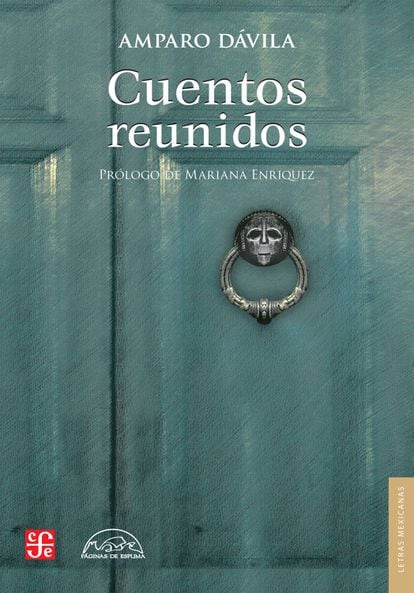Amparo Dávila was born and raised in Pinos, Zacatecas, a town located in the interior of Mexico and within the Gran Tunal desert, a place of tall yuccas, thickets, plateaus covered with gold and silver mines.
When reading her stories, strange beings appear, privacy devastated, houses, gardens with ponds, bourgeois families, the city.
Another landscape.
But her imagination grew in the midst of this gothic desert: there are no dust devils or sinkholes in her narrative, but there is an inexplicable desolation, a solitude as vast as the great spaces of her country.
In her text 'En la ruta al bristling', Jazmín Tapia Vázquez, a specialist in Dávila's work at UNAM, says that in 1965 the writer appeared at the Palacio de Bellas Artes in Mexico City for a "public accountability ”, a cycle of conferences.
He read an autobiographical text in which he defined Pinos as a mining town "with a past of gold and silver and a present of ruin and desolation", as a sad and gloomy place: "Behind the glass of my window there was no hope of life for me, and yes many omens of death;
I had lost my brother, and I was a sentenced and lonely girl”.
The family home was a nest of terror: “The wind filtered through the cracks in the doors and windows, penetrating the bones.
I was always cold, neither the fireplace in my room nor my dogs and cats could warm me up;
during the day I cried many times from cold, and at night from cold and fear... A woman dressed in white, with a lighted candle, very pale and without eyes, was looking for something through the night, the doors and furniture creaked, shadows passed, shapes, voices were heard,
sighs, moans, and a man with a wooden leg thumped as he walked, between the howling of the wind, the music of the phonographs, and the laughter of the prostitutes in the alley.
That's how the night passed, that's how many nights of my childhood passed."
On those nights I accompanied her
Dante's Divine Comedy
, in a copy illustrated by Gustave Doré.
It was a book that was in her grandfather's family library and that especially impacted her because of the images.
Bernardo Esquinca, writer and town crier of Dávila, remembers: “She herself explained that she grew up watching the funeral caravans that went to Pinos to bury her deceased, since it was the only nearby cemetery.
Whether in a cart or on the back of a mule, the dead paraded like 'a spectacle'.
A pitiless territory, drawings of fallen angels, caravans of corpses, a haunted house: Amparo's imagination was populated by unknown corners that would later explode in her four storybooks, her only narrative work —she was also a poet—:
Tiempo Shattered
(1959),
Concrete Music
(1961),
Petrified Trees
(1977) and
With Open Eyes
(2008).
She was compared to Edgar Allan Poe, to Julio Cortázar, to Alfonso Reyes;
her work is brief like that of her illustrious compatriots Juan Rulfo or Josefina Vicens.
It is discussed whether his work is a fantastic story, a horror story, a surrealist, a mixture, realism sprinkled with sinister: it happens that his work is unique and, yes, it leans towards the fantastic horror, with those minds that decompose in a morbid and irreparable, like that of the man who listens to the heart of the one he has murdered.
'Tales collected', by Amparo Dávila
But there is a very important difference in the work of Amparo Dávila and her monsters.
Most of its protagonists are women and narrators.
The point of view is another.
Was it the fantastic, as a non-mimetic genre, that helped her say things about women that could not be pronounced, for which perhaps language was elusive, recondite, secret, almost taboo?
Dávila's debut,
Weather Shattered
, was published by the Fondo de Cultura Económica: she was a respected writer, little read by the general public, cult despite her publishing house and rumors of her genius.
She had to wait for the reissue of her
Cuentos de ella reunited
in 2009 so that its numerous enthusiasts, including many academics —her work has been studied in classrooms since the 1980s in Mexico— and writers like Esquinca or Cristina Rivera Garza could be heard and Amparo Dávila finally read.
She died at the age of ninety-two in 2020, in Mexico City.
She had something of a diva, you have to see the photos of her: the black eyeliner around the eyes that look far away, the dark hair, always a cat next to her.
There are not many photos of Amparo Dávila, even less when she was young.
She lived in San Luis Potosí, where she studied middle and high school and published her first book of poems at age twenty-two,
Salmos Bajo la Luna
(1950);
then
Meditations on the shore of sleep
(1954) and
Profile of solitudes
(1954).
When she moved to Mexico City it was 1954 and she worked as an assistant to Alfonso Reyes: his move coincided with the writing of his first short stories.
She was a contemporary of Octavio Paz, Carlos Fuentes, Juan Rulfo, Elena Poniatowska, Margo Glantz and Julio Cortázar, with whom she maintained friendship, correspondence and who influenced her as a writer, from her second book.
Professor Alejandra Amatto from UNAM, a specialist in fantastic narrative, explains that “despite the fact that she was closely linked to the writers of her time, she always resisted being pigeonholed into a generation, in her case that of the Mexican Half-Century. .
She was in very important workshops in which she obtained scholarships to write and won the Xavier Villaurrutia award in 1977, which was one of the most important of her time”.
But Amparo was on the side,
in the back room: a bit like Silvina Ocampo.
She had privileges, but also economy in saying.
The writer Brenda Lozano collects an anecdote that Poniatowska told, and that she describes Amparo's imagination —and what she was capable of saying to her friends, besides her—.
Brenda tells what Elena wrote: “I remember that once in the fifties Amparo Dávila told me that she no longer wanted to drive because she felt —as in horror stories— that her car took her where he wanted, never where she had to. to go.
Halfway there she had to force him back to her house.
It seemed to me a very similar horror story to the one in her books and poetry.
'Death accompanies me, Elena'.
and that describes Amparo's imagination —and what she was capable of telling her friends, too—.
Brenda tells what Elena wrote: “I remember that once in the fifties Amparo Dávila told me that she no longer wanted to drive because she felt —as in horror stories— that her car took her where he wanted, never where she had to. to go.
Halfway there she had to force him back to her house.
It seemed to me a very similar horror story to the one in her books and poetry.
'Death accompanies me, Elena'.
and that describes Amparo's imagination —and what she was capable of telling her friends, too—.
Brenda tells what Elena wrote: “I remember that once in the fifties Amparo Dávila told me that she no longer wanted to drive because she felt —as in horror stories— that her car took her where he wanted, never where she had to. to go.
Halfway there she had to force him back to her house.
It seemed to me a very similar horror story to the one in her books and poetry.
'Death accompanies me, Elena'.
Halfway there I had to force him to return home.
It seemed to me a very similar horror story to the one in his books and poetry.
'Death accompanies me, Elena'.
Halfway there I had to force him to return home.
It seemed to me a very similar horror story to the one in his books and poetry.
'Death accompanies me, Elena'.
'Stories collected'.
Amparo Davila.
Foam Pages, 2022. 312 pages, 25 euros.
You can follow BABELIA on
and
, or sign up here to receive
our weekly newsletter
.



/cloudfront-eu-central-1.images.arcpublishing.com/prisa/JEEPQTR4AVGKDDJ24B4CKAATNY.jpg)
/cloudfront-eu-central-1.images.arcpublishing.com/prisa/IOQOCJLRXFFHVAIFFVFKAPDUG4.JPG)

/cloudfront-eu-central-1.images.arcpublishing.com/prisa/MI23BCFOBJATJDOOM7KTWZGRLU.jpg)

